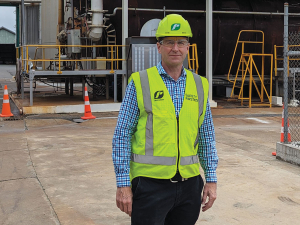MSA triumph
OPINION: Methane Science Accord, a farmer-led organisation advocating for zero tax on ruminant methane, will be quietly celebrating its first foray into fertiliser co-operative governance.
 Fertiliser use in New Zealand over the 18 months is about 25% down from what it consistently was for the previous decade or more, says Ravensdown chief operating officer Mike Whitty.
Fertiliser use in New Zealand over the 18 months is about 25% down from what it consistently was for the previous decade or more, says Ravensdown chief operating officer Mike Whitty.
Fertiliser use in New Zealand over the 18 months is about 25% down from what it consistently was for the previous decade or more, says Ravensdown chief operating officer Mike Whitty.
But while there are still some unknowns, including geopolitical developments and increasing focus on greenhouse gas mitigations, he sees the downturn as stabilising.
"We're very similar to where we were this time last year," Whitty told Dairy News.
He says the downturn was driven by Covid and an international squeeze on fertiliser supply that pushed prices up, in some cases by up to 300%, coupled with general inflation and a levelling off some "really good" pricing that farmers had been getting for their produce.
"You've had prices going up, revenue coming down and the economics have flowed into a pretty average position," he said.
"Some positives are coming through around dairy now, but sheep meat is at a seven-year low, pricewise. They are in a loss position, and they are the major consumers [of fertiliser] in New Zealand."
Ravensdown has had to retrench, letting about 18% of its staff go over the last year.
"We've done that; it was challenging," said Whitty, "But, you know, we're in a better position as a result for whatever comes down the line."
Whitty is confident Ravensdown shareholding farmers will see it through.
"We've seen it all before. This is just a bit more extended.
"Back in 2008 and 2009, we saw the same occurrence. We had very high prices. And then revenue came off. Demand came off and that took about three years to rebuild.
"It's all very cyclical. So, we've seen the fertiliser prices come off internationally quite significantly from where they were, and that's starting to flow through to better prices on farm, but you need the economics to support that.
"Dairy, for example, is less affected because they're in a neutral or a slightly profitable position. They're continuing on a higher level than sheep and beef farmers are."
Meanwhile, cropping needs annual nutrients to grow a reasonable crop so their demand doesn't tend to change significantly.
Whitty said that putting off maintenance fertilisers would be okay for a period but would start to reduce production going forward.
"Largely, you would say if you didn't use any nutrients, you'd see over time a 40 to 50 percent reduction in production. As you take nutrients out in food or fibre then you need to replace it."
But Ravensdown would only recommend what farmers economically need, and for the production at the level they are producing.
"And of course, we will work with the farmer on what decisions they need to make, because there will be budget constraints around some of them."
He adds that Ravensdown has a large environmental consultancy team to support farmers in meeting their reporting obligations to councils, milk companies and irrigators to show they improve on the efficiency of nutrient use while making sure not to have a negative impact on the environment.
While farmers are still waiting to see what the rules will be around greenhouse gas mitigation, Whitty says it is international customers such as Nestlé and Danone, that drive what's happening here, by putting their expectations onto us.
"The likes of Nestlé come to New Zealand and go, 'Right, we want to see what you're doing about your footprint and the environment'.
"So they're actually starting to incentivise better practices and supporting good practice. We're really starting to see that it's the customer that's moving us forward around outcomes.
"That's where the likes of urease-inhibited urea - N-protect - and the low-carbon urea, those sorts of things, are all seen as positive to reduce greenhouse gas emissions."
Whitty said the low-carbon urea brought in last year from the Saudi supplier Sabic was already getting interest from farmers. The N-Protect urease-inhibitive urea that reduces losses to the atmosphere has also been "picked up quite significantly".
Ravensdown was also doing a lot internally to make sure its own footprint was coming down, including moving away from coal use in the production of agricultural lime.
It has installed a biocombuster that uses wood to dry the rock at Dipton, and a large rock shed at the Geralding lime quarry that will store 10,000 tonnes of rock under cover.
That will allow it to air-dry naturally and keep it dry over winter before processing in optimal conditions in summer. The move is expected to completely replace an old coal-fired drying kiln at the site, so eliminating the transport and use of about 350 tonnes of coal a year.
A New Zealand dairy industry leader believes the free trade deal announced with India delivers wins for the sector.
The Coalition Government will need the support of at least one opposition party to ratify the free trade deal with India.
Primary sector leaders have welcomed the announcement of a Free Trade Agreement between India and New Zealand.
At Pāmu’s Kepler Farm in Manapouri, mating has wrapped up at the across-breed Beef Progeny Test.
More than 150 people turned up at Parliament recently to celebrate the 20th anniversary of Horticulture New Zealand (HortNZ).
Biosecurity New Zealand says Kiwis should continue to keep an eye out for yellow-legged hornets (Vespa velutina) over the holiday season.
President Donald Trump’s decision to impose tariffs on imports into the US is doing good things for global trade, according…
Seen a giant cheese roll rolling along Southland’s roads?